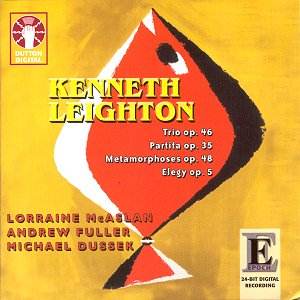Leighton composed his large-scale Partita for
Cello and Piano Op.35 in 1959. The first movement Elegy
opens with a dark ostinato in the piano over which the cello plays a
long arched phrase. Indeed the whole movement is a large-scale arch
form moving towards a powerful climax followed by a quieter coda Quasi
una marcia bringing the movement to its peaceful conclusion. This
is followed by a nervous Scherzo of some considerable complexity ending
with a muted coda. The third movement is a weighty theme and six contrasting
variations the last of which Chorale eventually achieves some
hard-won reconciliation.
Composed in 1965, the Piano Trio Op.46
also has three movements in which the thematic material is developed
from motifs heard at the outset of the first movement. To some extent,
the whole work is also some sort of theme and variations, a favourite
form in Leighton’s music. The first movement Allegro has a good
deal of harmonic ambiguity. Again, the second movement is a nervous
Scherzo with a lyrical trio. The reprise of the Scherzo main material
leads into the long final movement Hymn slowly building-up towards
a mighty climax before reaching a peaceful resolution.
The theme-and-variations structure is still carried
a step further in Metamorphoses for Violin and Piano Op.48
completed in 1966. The continuous variations however fall into three
main sections of which the central one is another capricious Scherzo
of some intensity followed by two slow, meditative variations which
eventually "seek for reconciliation rather than culmination"
(pace the composer).
These substantial works, from Leighton’s mature years,
are highly typical of this composer’s musical thinking, and intellectual
rigour and strict organisation never exclude intense expression characterising
Leighton’s rugged lyricism. No matter how complex it may be, Leighton’s
music always communicates in the most persuasive way.
The much earlier Elegy for Cello and Piano Op.5
dates from 1949. It was originally conceived as the slow movement of
a cello sonata which was never completed. It is a comparatively simpler
work, but still a telling example of Leighton’s lyricism in his early
career. A beautifully moving piece in its own rights that has – quite
deservedly so – become popular with cellists.
The major works recorded here all belong to Leighton’s
finest achievements. They clearly inhabit the same emotional world,
often a dark or pessimistic one, but one that is given a sincere, humane
expression. Leighton’s music is never indifferent. It always strongly
communicates with passion and intensity. All the pieces here certainly
strongly communicate thanks also to committed and dedicated performances
that make the best of these wonderful works. I now hope that Dutton
and these players might be persuaded to record Leighton’s Piano
Quartet Op.63 and Piano Quintet Op.34 as well
as the violin sonatas. An outright recommendation. This one will be
in my Top Ten for 2002.
Hubert Culot


